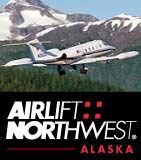 By ELIZABETH BLUEMINK Anchorage Daily News March 13, 2007
The weapon is new refuges. And two of them have been unsheathed this year on lands the mining industry is exploring.
The Legislature will review a proposal this year to create a 5 million- to 7 million-acre game refuge in Bristol Bay's headwaters, which would envelop the vast and controversial copper and gold Pebble mineral prospect, located in the headwaters of the world's largest sockeye fishery, subsistence fisheries and world-class sportfishing lodges. The Bristol Bay refuge bill proposed by state Sen. Gary Stevens, R-Kodiak, wouldn't take away Pebble's mining claims but it would prevent future dumping of mining waste. Hundreds of miles away, other Alaskans are targeting the Tangle Lakes region, with its large Nelchina caribou herd, as a possible refuge. Tensions over the Tangle Lakes are building. At the popular lake-dotted hunting and recreation area along the Denali Highway, Nevada Star Resources Corp., a Vancouver, British Columbia-based mining company, has sunk $14 million to explore for platinum, nickel and other minerals. The company plans to spend another $4 million this year. The Board of Game plans to review the Tangle Lakes refuge proposal again this fall after listening to testimony on it last week in Anchorage. The Alaska mining industry and its advocates are worried. Naidine Johnson owns mining claims in the area and is the longtime owner of the Tangle River Inn, which reaps business from mining firms that began poking around the hills in the 1990s. "It's a horrible thing they are trying to do. They are trying to get the miners out," said Johnson of the refuge's advocates. Refuges, however, have long been a tool to protect fish and animals on Alaska lands. "The ability to set aside areas is right in our constitution," said Lance Trasky, a former habitat biologist who supports Stevens' bill to create a Jay Hammond State Game Refuge in the Bristol Bay headwaters. "When people don't think there's enough protection, they want to ramp up the rules," added Larry Smith, a Homer builder and former state Board of Game member who is working with Stevens on the proposal. A similar chain of events occurred 30 years ago, in the midst of the trans-Alaska pipeline construction boom, soon after the Legislature created the Kachemak Bay Critical Habitat Area in the scenic bay next to Homer. Two years after creation of the critical habitat area, Gov. Jay Hammond asked the Legislature to ban oil rigs in Kachemak Bay and pay oil companies millions to buy back their leases. His request was locked in controversy until an exploration rig malfunctioned, spilling an estimated 200 gallons of diesel into the bay. A week later, the Legislature enacted the ban and agreed to buy back the drilling leases. The state classifies refuges, sanctuaries and critical habitat areas as lands essential to protect fish and wildlife. In them, state biologists have a greater role in managing the land, and developers must apply for special Fish and Game permits to ensure their projects don't conflict with the refuge's fish and wildlife protection goals. About 20 percent of Alaska - or 74 million acres, the size of Arizona - are designated refuges, most of it by the federal government. Many allow mining or oil drilling, though one in particular, the Arctic National Wildlife Refuge, has become synonymous with the epic struggle between conservation and resource exploitation. Since statehood in 1959, the Legislature has created 12 refuges, 17 critical habitat areas, three sanctuaries and two ranges for bison and moose. Not all refuges were created as barriers to development. The Legislature, which creates refuges, approved several on the western shore of Cook Inlet - such as Trading Bay, Susitna Flats and Redoubt Bay - as important hunting and fishing areas. These refuges allow oil drilling to continue as long as the rigs stay out of prime bird habitat.
Distributed to subscribers for publication by Scripps Howard News Service, http://www.scrippsnews.com Publish A Letter on SitNews Read Letters/Opinions
|
||


